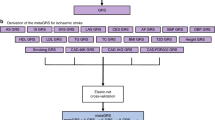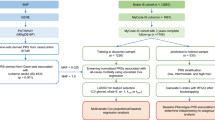Abstract
The utility of the polygenic risk score (PRS) to identify individuals at higher risk of stroke beyond clinical risk remains unclear, and we clarified this using Chinese population-based prospective cohorts. Cox proportional hazards models were used to estimate the 10-year risk, and Fine and Gray’s models were used for hazard ratios (HRs), their 95% confidence intervals (CIs), and the lifetime risk according to PRS and clinical risk categories. A total of 41,006 individuals aged 30–75 years with a mean follow-up of 9.0 years were included. Comparing the top versus bottom 5% of the PRS, the HR was 3.01 (95%CI 2.03–4.45) in the total population, and similar findings were observed within clinical risk strata. Marked gradients in the 10-year and lifetime risk across PRS categories were also found within clinical risk categories. Notably, among individuals with intermediate clinical risk, the 10-year risk for those in the top 5% of the PRS (7.3%, 95%CI 7.1%–7.5%) reached the threshold of high clinical risk (⩾7.0%) for initiating preventive treatment, and this effect of the PRS on refining risk stratification was evident for ischemic stroke. Even among those in the top 10% and 20% of the PRS, the 10-year risk would also exceed this level when aged ⩾50 and ⩾60 years, respectively. Overall, the combination of the PRS with the clinical risk score improved the risk stratification within clinical risk strata and distinguished actual high-risk individuals with intermediate clinical risk.
Similar content being viewed by others
References
Abraham, G., Malik, R., Yonova-Doing, E., Salim, A., Wang, T., Danesh, J., Butterworth, A.S., Howson, J.M.M., Inouye, M., and Dichgans, M. (2019). Genomic risk score offers predictive performance comparable to clinical risk factors for ischaemic stroke. Nat Commun 10, 5819.
Aragam, K.G., Dobbyn, A., Judy, R., Chaffin, M., Chaudhary, K., Hindy, G., Cagan, A., Finneran, P., Weng, L.C., Loos, R.J.F., et al. (2020). Limitations of contemporary guidelines for managing patients at high genetic risk of coronary artery disease. J Am Coll Cardiol 75, 2769–2780.
Buniello, A., MacArthur, J.A.L., Cerezo, M., Harris, L.W., Hayhurst, J., Malangone, C., McMahon, A., Morales, J., Mountjoy, E., Sollis, E., et al. (2019). The NHGRI-EBI GWAS Catalog of published genome-wide association studies, targeted arrays and summary statistics 2019. Nucleic Acids Res 47, D1005–D1012.
Dufouil, C., Beiser, A., McLure, L.A., Wolf, P.A., Tzourio, C., Howard, V. J., Westwood, A.J., Himali, J.J., Sullivan, L., Aparicio, H.J., et al. (2017). Revised Framingham Stroke Risk Profile to reflect temporal trends. Circulation 135, 1145–1159.
Elliott, J., Bodinier, B., Bond, T.A., Chadeau-Hyam, M., Evangelou, E., Moons, K.G.M., Dehghan, A., Muller, D.C., Elliott, P., and Tzoulaki, I. (2020). Predictive accuracy of a polygenic risk score-enhanced prediction model vs a clinical risk score for coronary artery disease. JAMA 323, 636–645.
Fine, J.P., and Gray, R.J. (1999). A proportional hazards model for the subdistribution of a competing risk. J Am Stat Assoc 94, 496–509.
Hachiya, T., Hata, J., Hirakawa, Y., Yoshida, D., Furuta, Y., Kitazono, T., Shimizu, A., and Ninomiya, T. (2020). Genome-wide polygenic score and the risk of ischemic stroke in a prospective cohort. Stroke 51, 759–765.
Han, F., Zhang, D.D., Zhai, F.F., Xue, J., Zhang, J.T., Yan, S., Zhou, L.X., Ni, J., Yao, M., Yang, M., et al. (2021). Association between large artery stenosis, cerebral small vessel disease and risk of ischemic stroke. Sci China Life Sci 64, 1473–1480.
Hankey, G.J. (2017). Stroke. Lancet 389, 641–654.
Hindy, G., Aragam, K.G., Ng, K., Chaffin, M., Lotta, L.A., Baras, A., Drake, I., Orho-Melander, M., Melander, O., Kathiresan, S., et al. (2020). Genome-wide polygenic score, clinical risk factors, and long-term trajectories of coronary artery disease. Arterioscler Thromb Vasc Biol 40, 2738–2746.
Hippisley-Cox, J., Coupland, C., Robson, J., and Brindle, P. (2010). Derivation, validation, and evaluation of a new QRISK model to estimate lifetime risk of cardiovascular disease: cohort study using QResearch database. BMJ 341, c6624.
Ibrahim-Verbaas, C.A., Fornage, M., Bis, J.C., Choi, S.H., Psaty, B.M., Meigs, J.B., Rao, M., Nalls, M., Fontes, J.D., O’Donnell, C.J., et al. (2014). Predicting stroke through genetic risk functions. Stroke 45, 403–412.
Jiang, X., Holmes, C., and McVean, G. (2021). The impact of age on genetic risk for common diseases. PLoS Genet 17, e1009723.
Kato, N., Loh, M., Takeuchi, F., Verweij, N., Wang, X., Zhang, W., Kelly, T.N., Saleheen, D., Lehne, B., Leach, I.M., et al. (2015). Trans-ancestry genome-wide association study identifies 12 genetic loci influencing blood pressure and implicates a role for DNA methylation. Nat Genet 47, 1282–1293.
Kavousi, M., and Schunkert, H. (2022). Polygenic risk score: a tool ready for clinical use? Eur Heart J 43, 1712–1714.
Khera, A.V., Emdin, C.A., Drake, I., Natarajan, P., Bick, A.G., Cook, N.R., Chasman, D.I., Baber, U., Mehran, R., Rader, D.J., et al. (2016). Genetic risk, adherence to a healthy lifestyle, and coronary disease. N Engl J Med 375, 2349–2358.
Lewington, S., Lacey, B., Clarke, R., Guo, Y., Kong, X.L., Yang, L., Chen, Y., Bian, Z., Chen, J., Meng, J., et al. (2016). The burden of hypertension and associated risk for cardiovascular mortality in China. JAMA Intern Med 176, 524–532.
Lu, X., Liu, Z., Cui, Q., Liu, F., Li, J., Niu, X., Shen, C., Hu, D., Huang, K., Chen, J., et al. (2022). A polygenic risk score improves risk stratification of coronary artery disease: a large-scale prospective Chinese cohort study. Eur Heart J 43, 1702–1711.
Lu, X., Niu, X., Shen, C., Liu, F., Liu, Z., Huang, K., Wang, L., Li, J., Hu, D., Zhao, Y., et al. (2021). Development and validation of a polygenic risk score for stroke in the Chinese population. Neurology 97, e619–e628.
Lu, X., Peloso, G.M., Liu, D.J., Wu, Y., Zhang, H., Zhou, W., Li, J., Tang, C.S., Dorajoo, R., Li, H., et al. (2017). Exome chip meta-analysis identifies novel loci and East Asian-specific coding variants that contribute to lipid levels and coronary artery disease. Nat Genet 49, 1722–1730.
Lu, X., Wang, L., Lin, X., Huang, J., Charles Gu, C., He, M., Shen, H., He, J., Zhu, J., Li, H., et al. (2015). Genome-wide association study in Chinese identifies novel loci for blood pressure and hypertension. Hum Mol Genet 24, 865–874.
Malik, R., Chauhan, G., Traylor, M., Sargurupremraj, M., Okada, Y., Mishra, A., Rutten-Jacobs, L., Giese, A.K., van der Laan, S.W., Gretarsdottir, S., et al. (2018). Multiancestry genome-wide association study of 520,000 subjects identifies 32 loci associated with stroke and stroke subtypes. Nat Genet 50, 524–537.
Marston, N.A., Patel, P.N., Kamanu, F.K., Nordio, F., Melloni, G.M., Roselli, C., Gurmu, Y., Weng, L.C., Bonaca, M.P., Giugliano, R.P., et al. (2021). Clinical application of a novel genetic risk score for ischemic stroke in patients with cardiometabolic disease. Circulation 143, 470–478.
Meschia, J.F., Bushnell, C., Boden-Albala, B., Braun, L.T., Bravata, D.M., Chaturvedi, S., Creager, M.A., Eckel, R.H., Elkind, M.S.V., Fornage, M., et al. (2014). Guidelines for the primary prevention of stroke. Stroke 45, 3754–3832.
Montaner, J., Ramiro, L., Simats, A., Tiedt, S., Makris, K., Jickling, G.C., Debette, S., Sanchez, J.C., and Bustamante, A. (2020). Multilevel omics for the discovery of biomarkers and therapeutic targets for stroke. Nat Rev Neurol 16, 247–264.
Mosley, J.D., Gupta, D.K., Tan, J., Yao, J., Wells, Q.S., Shaffer, C.M., Kundu, S., Robinson-Cohen, C., Psaty, B.M., Rich, S.S., et al. (2020). Predictive accuracy of a polygenic risk score compared with a clinical risk score for incident coronary heart disease. JAMA 323, 627–635.
Mujwara, D., Henno, G., Vernon, S.T., Peng, S., Di Domenico, P., Schroeder, B., Busby, G.B., Figtree, G.A., and Bottà, G. (2022). Integrating a polygenic risk score for coronary artery disease as a risk-enhancing factor in the pooled cohort equation: a cost-effectiveness analysis study. J Am Heart Assoc 11, e025236.
Neumann, J.T., Riaz, M., Bakshi, A., Polekhina, G., Thao, L.T.P., Nelson, M.R., Woods, R.L., Abraham, G., Inouye, M., Reid, C.M., et al. (2021). Predictive performance of a polygenic risk score for incident ischemic stroke in a healthy older population. Stroke 52, 2882–2891.
Pandian, J.D., Gall, S.L., Kate, M.P., Silva, G.S., Akinyemi, R.O., Ovbiagele, B.I., Lavados, P.M., Gandhi, D.B.C., and Thrift, A.G. (2018). Prevention of stroke: a global perspective. Lancet 392, 1269–1278.
Peloso, G.M., and Natarajan, P. (2018). Insights from population-based analyses of plasma lipids across the allele frequency spectrum. Curr Opin Genet Dev 50, 1–6.
Roth, G.A., Mensah, G.A., Johnson, C.O., Addolorato, G., Ammirati, E., Baddour, L.M., Barengo, N.C., Beaton, A.Z., Benjamin, E.J., Benziger, C.P., et al. (2020). Global burden of cardiovascular diseases and risk factors, 1990–2019: update from the GBD 2019 study. J Am Coll Cardiol 76, 2982–3021.
Rutten-Jacobs, L.C., Larsson, S.C., Malik, R., Rannikmäe, K., Sudlow, C. L., Dichgans, M., Markus, H.S., and Traylor, M. (2018). Genetic risk, incident stroke, and the benefits of adhering to a healthy lifestyle: cohort study of 306 473 UK Biobank participants. BMJ 363, k4168.
Sun, L., Pennells, L., Kaptoge, S., Nelson, C.P., Ritchie, S.C., Abraham, G., Arnold, M., Bell, S., Bolton, T., Burgess, S., et al. (2021). Polygenic risk scores in cardiovascular risk prediction: a cohort study and modelling analyses. PLoS Med 14, e1003498.
Tada, H., Shiffman, D., Smith, J.G., Sjögren, M., Lubitz, S.A., Ellinor, P.T., Louie, J.Z., Catanese, J.J., Engström, G., Devlin, J.J., et al. (2014). Twelve-single nucleotide polymorphism genetic risk score identifies individuals at increased risk for future atrial fibrillation and stroke. Stroke 45, 2856–2862.
Torkamani, A., Wineinger, N.E., and Topol, E.J. (2018). The personal and clinical utility of polygenic risk scores. Nat Rev Genet 19, 581–590.
Wang, W., Jiang, B., Sun, H., Ru, X., Sun, D., Wang, L., Wang, L., Jiang, Y., Li, Y., Wang, Y., et al. (2017). Prevalence, incidence, and mortality of stroke in China. Circulation 135, 759–771.
Wang, Y.J., Li, Z.X., Gu, H.Q., Zhai, Y., Jiang, Y., Zhao, X.Q., Wang, Y.L., Yang, X., Wang, C.J., Meng, X., et al. (2020). China Stroke Statistics 2019: a report from the National Center for Healthcare Quality Management in Neurological Diseases, China National Clinical Research Center for Neurological Diseases, the Chinese Stroke Association, National Center for Chronic and Non-communicable Disease Control and Prevention, Chinese Center for Disease Control and Prevention and Institute for Global Neuroscience and Stroke Collaborations. Stroke Vasc Neurol 5, 211–239.
Wolf, P.A., D’Agostino, R.B., Belanger, A.J., and Kannel, W.B. (1991). Probability of stroke: a risk profile from the Framingham Study. Stroke 22, 312–318.
Xing, X., Yang, X., Liu, F., Li, J., Chen, J., Liu, X., Cao, J., Shen, C., Yu, L., Lu, F., et al. (2019). Predicting 10-year and lifetime stroke risk in Chinese population. Stroke 50, 2371–2378.
Yang, X., Li, J., Hu, D., Chen, J., Li, Y., Huang, J., Liu, X., Liu, F., Cao, J., Shen, C., et al. (2016a). Predicting the 10-year risks of atherosclerotic cardiovascular disease in Chinese population. Circulation 134, 1430–1440.
Yang, X.L., Chen, J.C., Li, J.X., Cao, J., Lu, X.F., Liu, F.C., Hu, D.S., Liu, X.Q., Shen, C., Yu, L., et al. (2016b). Risk stratification of atherosclerotic cardiovascular disease in Chinese adults. Chronic Dis Transl Med 2, 102–109.
Acknowledgements
This work was supported by the Chinese Academy of Medical Sciences (CAMS) Innovation Fund for Medical Sciences (2021-I2M-1-010, 2019-I2M-2-003, and 2017-I2M-1-004), the National High Level Hospital Clinical Research Funding (2022-GSP-GG-1, 2022-GSP-GG-2), Research Unit of Prospective Cohort of Cardiovascular Diseases and Cancers, CAMS (2019RU038), the National Key Research and Development Program of China (2018YFE0115300 and 2017YFC0211700), the National Natural Science Foundation of China (82030102, 12126602, and 91857118), Taikang Yicai Public Health and Epidemic Control Fund (TKYC-GW-2020) and the National Clinical Research Center for Cardiovascular Diseases, Fuwai Hospital, Chinese Academy of Medical Sciences (NCRC2020006). We acknowledged the staff and participants from the China-PAR project for their participation and contribution.
Author information
Authors and Affiliations
Corresponding authors
Additional information
Compliance and ethics
The authors declare that they have no conflict of interest. This study was approved by the Institutional Review Board at Fuwai Hospital in Beijing, China.
Rights and permissions
About this article
Cite this article
Cui, Q., Liu, F., Li, J. et al. Integrating polygenic and clinical risks to improve stroke risk stratification in prospective Chinese cohorts. Sci. China Life Sci. 66, 1626–1635 (2023). https://doi.org/10.1007/s11427-022-2280-3
Received:
Accepted:
Published:
Issue Date:
DOI: https://doi.org/10.1007/s11427-022-2280-3




